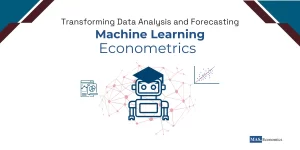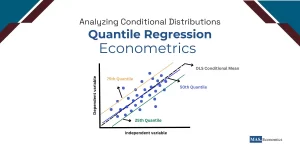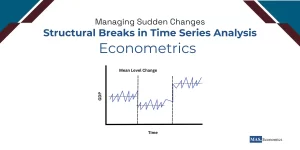Welcome to MASEconomics, your guide through the world of econometrics. In this first post of our series, discover the basics of econometrics and how it shapes economic analysis.
Let’s begin with explaining.
What is econometrics?
What is econometrics? In simple terms, econometrics is a powerful tool that combines economic theory, mathematical models, and statistical techniques to analyze and interpret economic phenomena. As a modern approach to understanding economic relationships, econometrics plays a crucial role in economics, allowing for empirical testing and forecasting. Whether you’re an aspiring econometrician, exploring introductory econometrics, or seeking to understand the complexities of quantitative economics, this guide will walk you through its foundational principles and applications.
Defining Econometrics
To dive deeper into what econometrics is, we must understand that it integrates various disciplines to measure economic relationships. For instance, Samuelson, Koopmans, and Stone describe econometrics as “the quantitative analysis of actual economic phenomena based on the concurrent development of theory and observation, related by appropriate methods of inference.” Similarly, Nobel Prize-winning economist Ragnar Frisch emphasized that econometrics unites statistics, economic theory, and mathematics. This sentiment is shared by other prominent economists like Lawrence Klein, who viewed econometrics as a way to predict economic behavior through quantitative methods.
Is Econometrics Difficult?
One of the common questions is, “Is econometrics hard?” While econometrics can seem challenging at first, understanding its key concepts—like regression models, data intricacies, and various econometric techniques—makes it manageable. Once you grasp the fundamentals, econometrics becomes an invaluable tool for decision-making and policy evaluation. For those starting their journey, Introductory Econometrics provides a clearer path, offering practical insights into complex quantitative economics.
The Importance of Econometrics
Econometrics serves as a bridge between economic theory and real-world data. This makes it essential for quantitative economic research and empirical econometrics, as it validates or refutes theoretical models by using statistical techniques. By transforming abstract theories into actionable insights, econometrics answers fundamental economic questions, such as:
- Does an increase in the minimum wage affect unemployment rates?
- What factors contribute to inflation in an economy?
- Can we predict the impact of fiscal policy on GDP growth?
The power of econometrics lies in its ability to connect abstract economic models with outcomes. It provides empirical content to economic relations for testing theories, decision-making, and policy evaluation. As a result, econometrics is widely used by governments, businesses, and institutions worldwide to develop data-driven strategies and evaluate the effectiveness of various economic policies.
Moreover, econometricians play an essential role in sectors like finance, healthcare, and education. With rising demand for data-driven insights, there are growing opportunities for econometrics jobs in both academia and the private sector. The field’s practical relevance is highlighted in areas like inflation forecasting, labor market analysis, and public policy evaluations.
The Role of Econometrics in Economics
In economics specifically, econometrics plays a critical role in bridging the gap between theory and practice. Econometrics helps economists take abstract models and apply them to real-world data, making it possible to assess relationships between variables like inflation, employment, and GDP growth. Here’s why econometrics is indispensable in the field of economics:
Testing Economic Theories
Economic theory suggests relationships between different variables, but econometrics is the tool that tests whether those relationships hold true in reality. For example, the famous Phillips Curve suggests that inflation and unemployment have an inverse relationship, but econometric analysis is necessary to validate this relationship under different economic conditions and periods.
Forecasting Future Trends
Econometric models are essential for making predictions about the future. Policymakers and businesses rely heavily on these forecasts to inform their decisions. Econometrics can forecast critical economic indicators like GDP growth, inflation, and employment, helping governments and businesses prepare for future economic challenges or opportunities.
Evaluating Policy Effectiveness
Governments implement policies to stimulate economic growth, reduce poverty, or control inflation. Econometrics helps evaluate the effectiveness of these policies by analyzing economic data before and after the policy’s implementation. For instance, econometric analysis can help assess whether a tax cut has led to increased business investment, or whether a new trade agreement has boosted exports.
Data-Driven Decision Making
In today’s data-driven world, the ability to turn data into actionable insights is a powerful skill. Econometrics enables businesses and governments to make better decisions by providing a clear, data-backed picture of the economic landscape. It helps convert vast amounts of economic data into insights that inform investment strategies, policy formulation, and market predictions.
The Key Econometric Models
At its core, econometrics involves building models that explain the relationships between variables. These models are used to test hypotheses, forecast trends, and evaluate policies. Below are some of the most common econometric models, which form the foundation of many economic analyses.
Simple Linear Regression Model
The simplest econometric model is the simple linear regression, which quantifies the relationship between two variables. In this model, one variable (the dependent variable) is predicted based on the value of another variable (the independent variable). The model is expressed mathematically as:
- \( Y \) is the dependent variable,
- \( X \) is the independent variable,
- \( \alpha \) is the intercept (the value of \( Y \) when \( X \) is zero),
- \( \beta \) is the slope coefficient (showing how much \( Y \) changes for a one-unit change in \( X \)),
- \( \epsilon \) represents the error term, capturing other factors that might influence \( Y \).
An example could be estimating the effect of income on consumption. In this case, \( Y \) would be consumption, \( X \) would be income, and \( \beta \) would represent the increase in consumption for every additional dollar of income.
Multiple Regression Model
The multiple regression model extends simple regression by including more than one independent variable. This allows us to analyze how several factors influence the dependent variable at once, providing a more comprehensive view of the economic relationship. The model is expressed as:
This approach is particularly useful when looking at complex relationships, such as the factors driving GDP growth, where multiple variables (e.g., investment, government spending, inflation, etc.) can interact with each other.
Time Series Models
Time series econometrics deals with data observed over time. Economists use these models to identify trends, cyclical patterns, and relationships that evolve over time. A common time series model is the ARMA (AutoRegressive Moving Average) model, which combines two elements:
- Autoregression: the idea that future values of a variable depend on its past values,
- Moving Average: where future values depend on past forecast errors.
Time series models are essential for making economic forecasts, such as predicting future inflation, GDP growth, or stock market performance based on past trends. Time series models also account for seasonality and business cycles, providing more accurate predictions over time.
Panel Data Models
Panel data models analyze data across both time and cross-sectional dimensions. This means you can observe multiple individuals or entities (such as countries, companies, or households) over several time periods. By combining time series and cross-sectional data, panel data models allow for more precise analysis of dynamic relationships.
For example, if you’re studying the impact of a new policy on income inequality across different countries, panel data can help track the changes within each country over time, while also comparing them across different nations.
Binary Outcome Models
Some econometric models deal with situations where the dependent variable is binary—that is, it takes on one of two values, such as “yes” or “no.” These are called binary outcome models, and two common types are the Probit and Logit models. These models are used to predict the probability of an event occurring, such as whether a person will default on a loan or whether a policy will pass in a legislative body.
Binary outcome models are often used in economic policy analysis, marketing, and finance to understand behavior in yes/no decisions, such as whether a consumer will purchase a product.
Practical Applications of Econometrics
Econometrics is not limited to theory; its practical applications are numerous and wide-ranging. Below are a few examples of how econometrics is used to solve real-world problems in economics.
Forecasting Inflation and Economic Growth
Econometric models play a critical role in forecasting important economic indicators like inflation, GDP growth, and employment rates. Central banks and financial institutions use time series econometrics to predict future inflation trends by analyzing variables like interest rates, money supply, and unemployment rates.
Understanding Labor Market Dynamics
Econometric models are essential for understanding the relationship between education, wages, and employment. By controlling for variables like experience and industry, econometrics can help policymakers assess whether educational reforms have successfully improved labor market outcomes or if raising the minimum wage leads to unemployment.
Evaluating Public Policies
Econometrics is a vital tool for evaluating the effectiveness of public policies. Whether it’s a tax cut, a welfare program, or a trade agreement, econometric models help quantify the impact of these policies on key outcomes like employment, poverty, and economic growth. By comparing data before and after a policy is implemented, econometricians can assess its real-world effects.
Asset Pricing in Financial Markets
Econometrics is crucial for understanding financial markets. Time series models help investors forecast stock prices, interest rates, and currency fluctuations, allowing them to manage risks and optimize investment portfolios. Financial econometrics also plays a key role in pricing derivatives, managing portfolio risk, and predicting market volatility.
Overcoming Challenges in Econometrics
While econometrics offers powerful tools for understanding complex economic relationships, it also presents challenges. For instance:
Multicollinearity
This occurs when two or more independent variables are highly correlated, making it difficult to isolate their individual effects. When this happens, econometricians use techniques like variance inflation factors (VIF) to detect multicollinearity and adjust models accordingly.
Heteroscedasticity
When the variance of error terms is not constant across observations, it leads to heteroscedasticity, which can distort the efficiency of estimators. Techniques such as robust standard errors or Generalized Least Squares (GLS) are applied to correct this issue.
Autocorrelation
In time series data, autocorrelation occurs when error terms are correlated over time. This can lead to incorrect inferences, especially in forecasting models. The Durbin-Watson test is commonly used to detect autocorrelation, and advanced methods like ARIMA models are employed to handle such challenges.
Conclusion
Econometrics is more than just a tool for economists; it’s the language through which data speaks. As we look ahead, econometrics will continue to evolve, integrating big data, machine learning, and artificial intelligence to provide even deeper insights. Whether you are forecasting market trends or evaluating the impact of economic policies, econometrics provides the tools needed to turn raw data into actionable insights.
This post serves as the foundation for understanding econometrics. In future discussions, we will explore topics such as regression models, time series econometrics, and methods for addressing common challenges like heteroscedasticity and multicollinearity.
FAQs:
What is econometrics in simple terms?
Econometrics is a field that combines economic theory, mathematical models, and statistical techniques to analyze economic data. It helps to understand and quantify economic relationships, providing insights into how different economic variables interact.
Why is econometrics important in economics?
Econometrics is crucial for validating economic theories and making data-driven decisions. It allows economists to test hypotheses, forecast future trends, and evaluate the impact of policies, turning abstract theories into actionable insights.
Is econometrics difficult to learn?
While econometrics can be challenging due to its reliance on statistics and mathematics, mastering the basics like regression models and data analysis makes it manageable. With practice, it becomes a valuable tool for understanding complex economic phenomena.
What are some real-world applications of econometrics?
Econometrics is used in various fields, including forecasting inflation, analyzing labor market dynamics, evaluating public policies, and asset pricing in financial markets. It helps governments, businesses, and investors make informed decisions based on data.
What are the key econometric models?
Key econometric models include simple linear regression, multiple regression models, time series models like ARMA, panel data models, and binary outcome models like Probit and Logit. Each model helps analyze different types of economic data and relationships.
Thanks for reading! If you found this helpful, share it with friends and spread the knowledge.
Happy learning with MASEconomics




